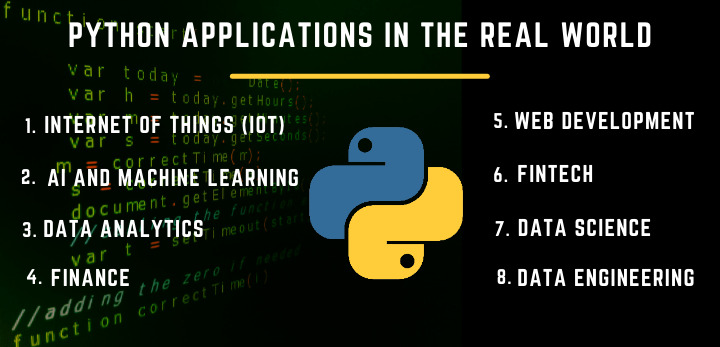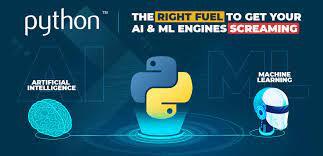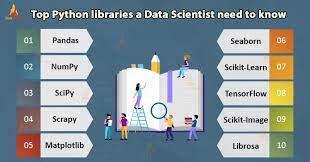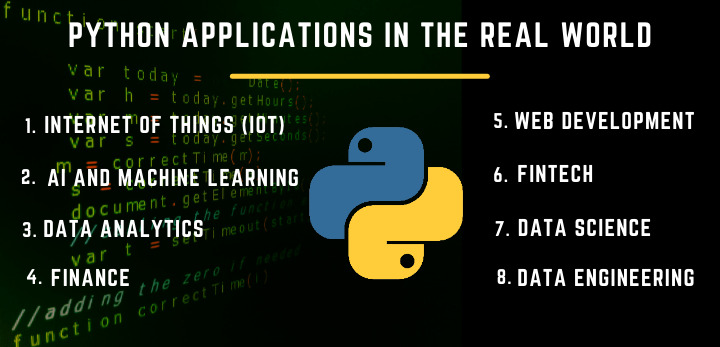Introduction
Can you imagine a day in your life when you go around doing your regular chores without using an app? Probably not. That is because we live in a digital world. Software applications act as the backbone for any industry – healthcare, banking, military, insurance, and many more. All these applications use a wide range of programming languages. But, Python stands out from the rest because it is the most user-friendly and flexible. This explains why 80% of developers worldwide use Python for coding. To understand the secret behind the popularity of this language, shall explore the top 10 Python applications in real world.

Why is Python the best programming language?
Let us understand why coders love Python amongst all other programming languages. I can sense your curiosity rising. So, let me list down some of the factors that make this dynamic, interpreted, object-oriented high-level programming language score above others. Here you go…
- Easy to learn and use
- Has a rich collection of libraries, frameworks, and tools
- Flexible, versatile, efficient, fast
- Secure
- Scalable
- Automates tasks
This is not an exhaustive list. But these features can be enough to explain why Python is impacting Artificial Intelligence, Machine Learning, and even Data Science. It further explains why Python is a great tool for building software applications. Knowing about the features, however, is not enough to appreciate the power of this language. The real accomplishment lies in the usage of any language in real-life applications.
Therefore, in this blog, we explore Python’s top 10 real-life applications to unravel the secret behind its phenomenal success. The objective is to traverse the thrilling landscape of Python uses in real life. Let’s start the exciting journey…
1. Web Development
Python is the favourite Web development language because of its wide array of frameworks and robust Content Management System (CMS). Some popular examples of Web development frameworks include Flask, Django, Bottle, Pyramid etc. Django CMS, Plone CMS, and Wagtail are some fantastic examples of CMS.
Python offers the additional advantages of security and scalability – extremely crucial factors for successful Web development. Instagram is an example of a Python application built using the Django framework.
2. Game Development
Considering the ease with which coders can use Python for Web development, it is obvious that it is a great tool for developing interactive games – one of the many uses of Python in real world. In fact, the popular shooter game of 2000s Battlefield 2 was developed using Python. Some other widely used games such as Pirates of the Caribbean, Bridge Commander etc. also use Python for coding. The availability of popular 2D and 3D gaming libraries is the main reason why developers love to use Python for game development.
3. Artificial Intelligence and Machine Learning
In Artificial Intelligence and Machine Learning, we use historical data or create algorithms to train the computer. Python is best suited for this purpose of all programming languages because its rich repository of inbuilt libraries and tools. This facilitates the creation of algorithms. Some examples are Numpy for complex data analysis, Keras for Machine Learning ScipY for technical computing, and Seaborn for data visualization. Interesting to note that all of them offer simple, crisp, and readable code, Therefore, developers can code complex algorithms with ease. This is another example of Python uses in real life.

4. Desktop GUI Applications
Just as Python makes life easy for coders for Web development and Game development, you can experience the ease of use even at the time of desktop programming. The flexibility in coding makes it an appropriate choice for highly responsive and superfast desktop-based GUI applications. Additionally, its modular architecture, ability to work on multiple Operating Systems and easy-to-understand syntax are the other potent weapons in its arsenal. Some of the tools and frameworks that coders commonly use to develop GUI applications include Tkinter, PyQt, Kivy, WxPython etc. Yet another powerful example of Python uses in real life.
5. Software Development
As we gradually understand why Python is the most sought-after programming language, its use in software development becomes an obvious choice. To be precise, quick execution, high compatibility, a strong community network, and a vast collection of libraries and frameworks facilitate the building of some software development tools such as Roundup, Mercurial, Orbiter, Buildbot, Allura etc. These tools, in turn, promote the uses of Python in real world.
More importantly, Python works with emerging technologies like Artificial Intelligence, Machine Learning, and Data Science. In fact, programmers use it as a support programming language for project management, build, control and testing.
You will find it fascinating to know that applications like Google, Netflix, and Reddit all use Python. I believe, this once again reinforces the overwhelming presence of Python in developing real-life applications.
6. Business Applications
This is another category where Python uses in real life score high. Very different from normal applications, Business applications cover domains such as e-commerce, ERP etc. Unlike other applications, they need to cater to organisational requirements, instead of individual needs. Also, Business applications often need to integrate with legacy systems. They need a language that is scalable, reliable, extensible, and easily readable – Python offers all these features and much more.
For instance, its inbuilt libraries and tools contain Odoo a business management software that provides automated solutions for business processes. Tryton is another example of easy-to-use open-source business software. It has fully integrated features like Financial Accounting, Sales, Customer Relationship Management, Procurement, Shipping, and many more. They help businesses manage their processes end-to-end. This is indeed an excellent example of a Python application in the real world.
7. Data Science and Data Validation
Data is currently the lifeline of businesses around the world. This is because data gives insight into the mind of customers and thereby help to devise and fine-tune business strategies. Commonly referred to as Data Science, it starts with identifying the problem., collecting data to understand the extent of the problem, followed by data processing, data exploration, data analysis, and finally data visualization to present the findings.
The Python ecosystem is enriched with several libraries like TensorFlow, PyTorch, Pandas, NumPy, SciPy etc. They specialize in creating and improvising Deep Learning and Machine Learning Models for extensive data crunching and data manipulation.
Even for Data Visualization, Python contains libraries such as Plotly, Seaborn, and Ggplot. Overall, the inbuilt libraries and tools form the backbone, promoting the uses of Python in real world.

8. Operating Systems
Interestingly, Python is the secret ingredient behind several operating systems, particularly the Linux series. The use of Python for creating the brain of the computer started with the birth of Ubuntu’s Ubiquity, Red Hat’s Anaconda and Fedora. The power of this language in developing Operating Systems is further enhanced when combined with C. It is noted that this potent combination of Python and C is highly beneficial for designing and developing Operating Systems.
9. Web Scraping Applications
Another instance of Python application in the real world is the Web Scraping Application. Businesses use them to scrap huge volumes of data. They use this data to extract customer information used as input for framing business decisions. Python uses tools like PythonRequest, Selenium, and MechanicalSoup for building Web scraping applications. Python further aids business decision-making by tackling huge volumes of data with ease. In the process, Python facilitates business decision-making and reinforces the uses of Python in real world.

10. Scientific and Numeric Applications
Apart from projects applying Artificial Intelligence, Machine Learning or Data Science, there are some applications that need intensive computations in the form of linear algebra and advanced mathematical functions. Even in such cases, Python has something to offer from its repository of libraries and tools. Using them, scientists quickly solve number-crunching problems and arrive at new findings for the scientific world.
FreeCAD, a 3DModelling software and Abacus, a finite element method software, are both coded in Python. These are other striking examples of Python uses in real life.
Summing Up
That brings us to the end of the list of the top 10 Python applications in the real world. The diverse range of applications covered above explains Python is the most loved programming language for coders across the world. As shared earlier, its rich collection of libraries and tools is unparallel.
Another factor that contributes to Python’s exceptional popularity is its easy syntax very similar to the English language. This makes it simple for beginners to gain a grasp of the language. Moreover, compared to other programming languages, Python has a shorter learning curve. This makes it an obvious choice for training courses across the globe.
So, its learning ease makes it a favourite among the starters. The rich armoury of libraries and tools helps professional coders create wonders with their code.
In brief, Python proves to be an uncontested winner amongst other programming languages. In real-world applications, Python uses in real life makes life better, simpler, and easier, for individuals and businesses.
Frequently Asked Questions
The main reason that makes Python the obvious choice for developing real-time applications is the ease of syntax and coding in comparison to other programming languages like Java or C++. The libraries and frameworks of Python are the additional advantages in favour of Python.
Programmers commonly use Python for developing websites and software, automating tasks, analyzing data, and visualizing data. Even non-programmers like accountants and scientists use Python for everyday tasks because of its ease of learning. In fact, uses of Python in real world makes this language an undisputed leader.
If you are planning to study Python, you are absolutely on the right track. Python is one of the most widely used programming languages and has a very bright prospect in the job market. This results in high demand for Python programmers so that they enjoy high salaries in the industry compared to their peers.
The simple syntax and easy readability of the Python language enable programmers to solve complex machine-learning problems. As a result, they are spared the time and effort to solve complex technical issues of the language.
One major challenge that Python programmers face is the design issue of the language. This issue throws up runtime errors. More exhaustive testing can help to resolve the design issues.











Recent Comments